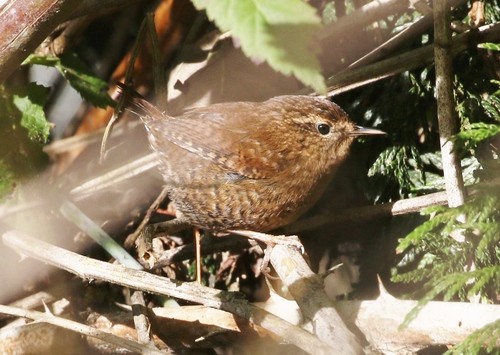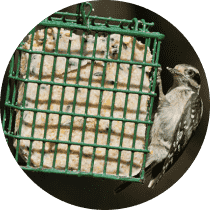Pacific Wren
A species of Troglodytes Scientific name : Troglodytes pacificus Genus : Troglodytes
Pacific Wren, A species of Troglodytes
Botanical name: Troglodytes pacificus
Genus: Troglodytes
Content
Description General Info
 Photo By silversea_starsong , used under CC-BY-NC-4.0 /Cropped and compressed from original
Photo By silversea_starsong , used under CC-BY-NC-4.0 /Cropped and compressed from original Description
Rufous brown above, richly colored below, barred with darker brown and dusky, even on wings and tail. The bill is dark brown, the legs pale brown. Young birds are less distinctly barred. 
Size
10 cm
Colors
Brown
Bronze
Life Expectancy
4-7 years
Nest Placement
Cavity
Clutch Size
1 - 9 eggs
Incubation Period
1 - 2 broods
Number of Broods
14 - 17 days
Nestling Period
15 - 17 days
Feeding Habits
Pacific Wren primarily consume insects, including beetles, caterpillars, ants, and arachnids like spiders and mites. They forage by hopping on or just above the ground, investigating crevices and decaying wood. They pick or probe for prey on surfaces and, occasionally, eat juniper berries in the nonbreeding season.
Habitat
Pacific Wren primarily thrives in dense, old-growth coniferous forests across western North America, from sea level to impressive elevations of 12,000 feet. Optimal habitats blend proximity to water with rich ground cover such as fallen logs and lush understory vegetation. In winter, some descend to scrub oak and pinyon-juniper forests, occasionally adapting to urban green spaces.
Nest Behavior
Male pacific Wren initiate nest construction while females contribute by lining the interior. The species demonstrates flexible egg-laying patterns, with dedicated parental care for both eggs and offspring.
Nest Characteristics
Pacific Wren create dome-shaped globular nests within natural cavities, often found near streams and varying in height up to 23 feet. These nests are camouflaged with moss, bark, twigs, and other plant materials, and lined with feathers and animal hair.
Dite type
Insectivorous
General Info
Feeding Habits
Bird food type
Bird Feeder Type

Platform

Suet Cage
Sounds
Song
Recording location: United States
Behavior
Pacific Wren exhibit an active and energetic lifestyle, engaging in short flights through the understory with rapid wingbeats and navigating their environment with a mouselike agility. Habitually, they can be observed scurrying along the forest floor, hopping on fallen logs, or even clinging to vertical tree trunks, mirroring the behavior of the Brown Creeper. Notably, pacific Wren express a constant bobbing behavior, nodding their heads or bodies even when static. With a keen sense of territory, they are predominantly solitary outside of the mating season, where interactions intensify: males sing emphatically and exhibit fluttering wings and animated tail movements to attract females. The breeding display extends to showcasing multiple nests to a prospective mate, with the female making the final selection for nesting. Their territorial nature persists year-round, albeit with contracted boundaries during off-season months.
Species Status
Not globally threatened.
Scientific Classification
Phylum
Chordates Class
Birds Order
Perching birds Family
Wrens Genus
Troglodytes Species
Pacific Wren